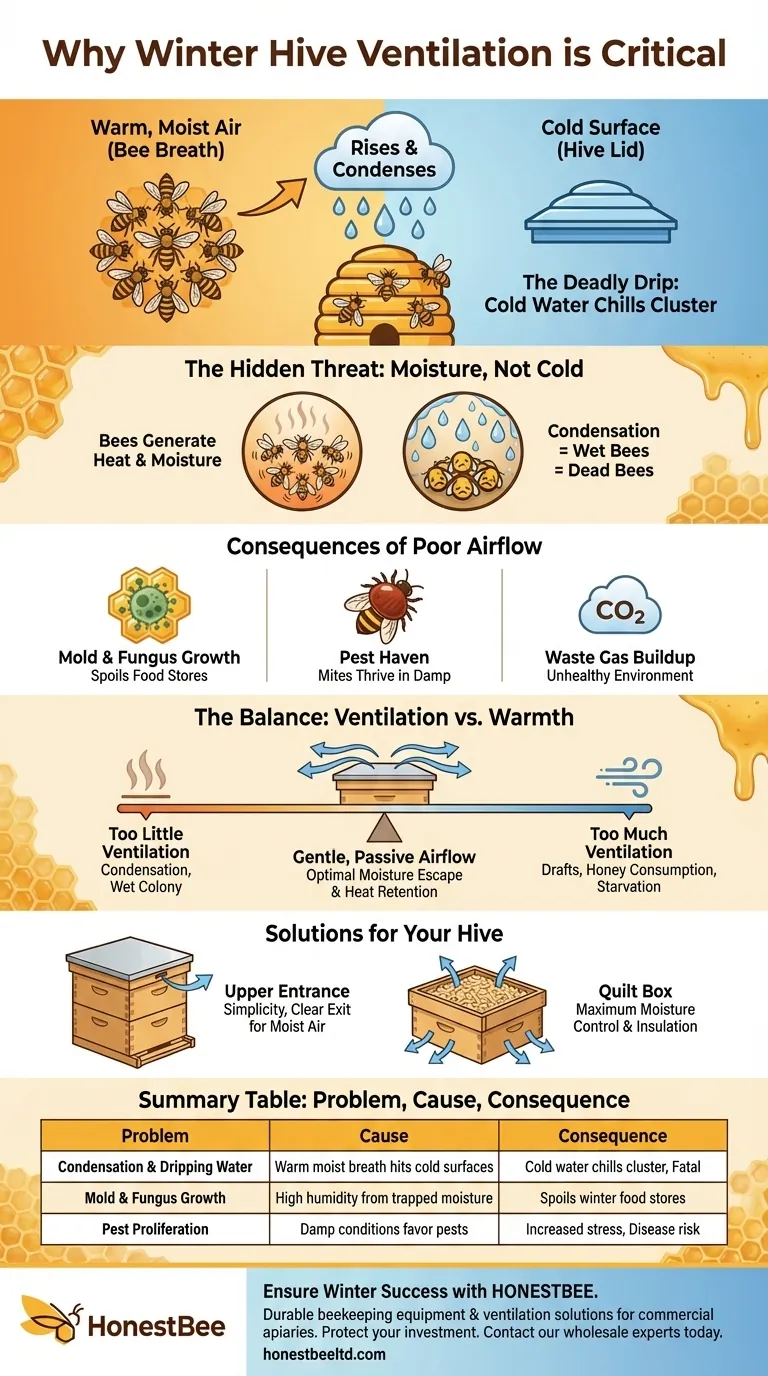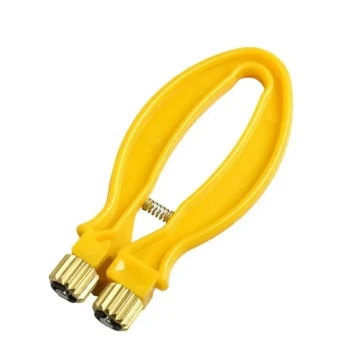In short, proper winter hive ventilation is critical to prevent moisture from killing your bees. While it seems counterintuitive to let cold air into the hive during winter, a lack of airflow creates condensation. This condensation can drip cold water onto the winter cluster, chilling and ultimately killing the colony far more effectively than the cold air itself.
The greatest threat to a honeybee colony in winter is not the cold, but the moisture the colony itself produces. Effective ventilation provides a controlled escape route for this damp air, keeping the bees dry and healthy.

The Hidden Threat: Moisture, Not Cold
Many beekeepers assume their primary winter task is to keep the hive warm. However, bees are remarkably effective at generating their own heat. The real challenge is managing the byproducts of their life-sustaining activity: heat and water vapor.
How Bees Generate Moisture
During winter, bees form a tight cluster and vibrate their wing muscles to generate heat. This metabolic process, like our own breathing, releases warm, moist air. A strong colony can release a significant amount of water vapor into the hive's atmosphere each day.
The Physics of Condensation
This warm, moisture-laden air rises. When it hits a cold surface, such as the inner cover or hive lid, it rapidly cools and condenses into liquid water droplets. This is the same principle that causes your windows to fog up on a cold day.
The Deadly Drip
Without a way to escape, this condensation gathers and eventually drips back down. Cold water falling directly onto the bee cluster is a death sentence. It instantly chills the bees, making it impossible for them to maintain their cluster temperature, leading to hypothermia and death.
The Consequences of Poor Airflow
Beyond the immediate danger of cold water, trapped moisture creates a generally unhealthy environment inside the hive that can lead to secondary problems.
Promoting Mold and Fungus
High humidity is the perfect breeding ground for mold and fungus. These can grow over stored honey and pollen frames, spoiling the bees' vital winter food stores and creating an unsanitary environment.
Creating a Haven for Pests
Pests like Varroa mites thrive in damp conditions. A humid hive makes it easier for pest populations to flourish, placing additional stress on the already-taxed winter colony.
Buildup of Waste Gases
Bee respiration also produces carbon dioxide. While not as immediate a threat as moisture, proper ventilation ensures waste gases are flushed out and replaced with fresh air, maintaining the colony's overall health.
Understanding the Trade-off: Ventilation vs. Warmth
Achieving the right level of ventilation is a delicate balance. The goal is not to create a drafty, cold hive but to provide just enough airflow to carry moisture away.
The Danger of Too Little Ventilation
As we've established, this is the most common and dangerous scenario. It leads directly to condensation and a wet, sick colony. It is the primary problem to be solved.
The Danger of Too Much Ventilation
Excessive airflow can create a draft. This forces the bee cluster to consume more of their honey stores to generate enough heat to compensate for the heat loss, potentially causing them to run out of food before spring. The key is gentle, passive airflow, not a strong breeze.
Making the Right Choice for Your Hive
The goal is to allow moist air to exit without creating a wind tunnel. Your specific climate and hive setup will determine the best method.
- If your primary focus is simplicity and avoiding fatal condensation: Ensure you have a small upper entrance or prop the inner cover up slightly to give warm, moist air a clear exit path.
- If your primary focus is maximum moisture control in a very cold climate: Consider using a "quilt box," which uses wood shavings to absorb moisture while providing insulation.
Ultimately, keeping your bees dry is the most important task for successful winter beekeeping.
Summary Table:
| Problem | Cause | Consequence |
|---|---|---|
| Condensation & Dripping Water | Warm, moist bee breath hits cold hive surfaces. | Cold water drips on the cluster, causing fatal chilling. |
| Mold & Fungus Growth | High humidity from trapped moisture. | Spoils winter food stores (honey/pollen). |
| Pest Proliferation | Damp conditions favor pests like Varroa mites. | Increased stress and disease risk for the colony. |
Ensure your apiary is equipped for winter success. HONESTBEE supplies durable, well-designed beekeeping equipment and ventilation solutions to commercial apiaries and distributors. Protect your investment and ensure your colonies survive and thrive through the coldest months. Contact our wholesale experts today to discuss your winter hive management needs.
Visual Guide

Related Products
- Professional Insulated Winter Hive Wrap for Beekeeping
- Inner Beehive Cover for Beekeeping Bee Hive Inner Cover
- Long Langstroth Style Horizontal Top Bar Hive for Wholesale
- Professional Drop-Style Hive Handles for Beekeeping
- Professional Grade Foldable Beehive Handles
People Also Ask
- What are the steps to properly wrap a beehive for winter? Ensure Your Colony Survives the Cold
- Why is it important to insulate beehives during winter? Boost Your Colony's Survival Rate
- Is it always necessary to insulate beehives? A Guide to Winter Survival & Colony Health
- What are the durability features of Bee Blankets? Built to Last in Demanding Apiary Conditions
- What is the advantage of an insulated outer cover? Boost Winter Survival & Spring Buildup



















